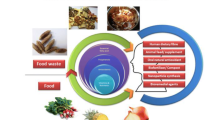Abstract
The enzymatic reduction of sinapic acid ester content in canola meal using polyphenol oxidase from the fungusT. versicolor was investigated. To determine the effectiveness of this new process, the results obtained using two spectrophotometric methods and an HPLC analytical method for assaying sinapic acid ester content in the treated and untreated meals were compared. It was found that all the methods gave practically the same results when the samples from untreated canola meals were analysed. However, both of the spectrophotometric methods overestimated the sinapic acid ester content in the enzymatically treated meal by 7%–20%, as compared to the results obtained using HPLC. It was found that the sensitivity limits for the spectrophotometric methods used for the determination of sinapic acid ester content in enzymatically treated canola meals were 2.67 g and 1.47 g phenolics/kg meal for the direct and chemical spectrophotometric methods respectively. A correlation between the results obtained using the spectrophotometric and HPLC methods is given. The enzymatic treatment resulted in a negligible amount of phenolics in the treated meal.
Similar content being viewed by others
References
Austin FL, Wolff IA (1968) Sinapine and related esters in seed meal ofCrambe abyssinica. J Agric Food Chem 16:132–135
Bell JM (1993) Factors affecting the nutritional value of canola meal: a review. Can J Anim Sci 73:679–697
Bjerg B, Olsen O, Rasmussen KW, Sorensen H (1984) New principle of ion-exchange techniques suitable to sample preparation and group separation of natural products prior to liquid chromatography. J Liquid Chromatogr 7:691–707
Blair R, Richter RD (1984) Carbohydrate and phenolic constituents in a comprehensive range of rapeseed and canola fractions: nutritional significance for animals. J Sci Food Agric 35:29–35
Bouchereau A, Hamelin J, Lamour I, Renard M, Larher F (1991) Distribution of sinapine and related compounds in seeds ofBrassica and allied genera. Phytochemistry 30:1873–1881
Butler EJ, Pearson AW, Fenwick GR (1982) Problems which limit the use of rapeseed meal as a protein source in poultry diets. J Sci Food Agric 33:866–875
Clandinin DR (1961) Effect of sinapin, the bitter substance in rapeseed oil meal, on the growth of chickens. Poultry Sci 40:484–487
Clandinin DR, Robblee AR, Bell JM, Slinger SJ (1986) Composition of canola meal. Canola Council Publications 59:5–7
Clausen S, Olsen O, Sorensen H (1983) Separation of aromatic choline esters by high-performance liquid chromatography. J Chromatogr 260:193–199
Dabrowski KJ, Sosulski FW (1984) Quantitation of free and hydrolyzable phenolic acids in seeds by capillary gas-liquid chromatography. J Agric Food Chem 32:123–127
Fenton TW, Leung J, Clandinin DR (1980) Phenolic components of rapeseed meal. J Food Sci 45:1702–1710
Fenwick GR (1979) A micromethod for the screening of individual seeds and cotyledons ofBrassica napus andBrassica campestris (rapeseed) for low sinapine content. J Sci Food Agric 30:661–663
Fenwick GR, Hobson-Frochok A, Land DG, Curtis RF (1979) Rapeseed meal and egg taint: treatment of rapeseed meal to reduce tainting potential. Br Poult Sci 20:323–329
Goh YK, Shires A, Robblee AR, Clandinin DR (1982) Effect of ammoniation of rapeseed meal on the sinapine content of the meal. British Poultry Sci 23:121–128
Henning W (1982) Schnell Sinapin-Bestimmung mit Ionen-Paar HPLC aus Speisesenf und Senfsaaten. Z Lebensm Unters Forsch. 175:345–348
Ismail F, Eskin NAM (1979) A new procedure for determination of sinapine. J Agric Food Chem 27:917–918
Khan AW, Overend RP (1990) An oxygenase enzyme system fromTrametes versicolor. FEMS Microbiol Lett 66:215–220
Kolovrat O (1990) Stanoveni sinapinu v semeni repky. Rostl Vyroba 36:329–333
Kozlowska H, Rotkiewicz DA, Zadernowski R, Sosulski FW (1983) Phenolic acids in rapeseeds and mustard. JAOCS 60:1119–1123
Krygier K, Sosulski F, Hogge L (1982) Free, esterified, and insoluble-bound phenolic acids: 2. Composition of phenolic acids in rapeseed flour and hulls. J Agric Food Chem 30:334–336
Lacki K, Duvnjak Z, (1994) Production and utilization of an oxygenase for the reduction of sinapic acid esters content in canola meal. In: Wiseman A (ed) Applied Biocatalysis Biotechnology. Institution of Chemical Engineers (ICHEME), Rugby, Warwickshire, UK, pp 28–30
Macheix J-J, Fleuriet A, Billot J (1990) Fruit phenolics. CRC, Boca Raton, Fla
Mueller MM, Ryl EB, Fenton T, Clandinin DR (1978) Cultivar and growing location differences on the sinapine content of rapeseed. Can J Anim Sci 58:579–583
Naczk M, Diosady LL, Rubin LJ (1986) The phytate and complex phenol content of meals produced by alkanol-ammonia/hexane extraction of canola. Lebensm Wiss Technol 19:13–17
Naczk M, Wanasundara PKJPD, Shahidi F (1992) Facile spectrophotometric quantification method of sinapic acid in hexane-extracted and methanol-ammonia-water-treated mustard and rapeseed meals. J Agric Food Chem 40:444–448
Pink D, Naczk M, Baskin K, Shahidi F (1994) Theoretical analysis of ultraviolet—visible spectra of various phenolic acid fractions of canola. J Agric Food Chem 42:1317–1322
Shahidi F (1990) Rapeseed and canola: global production and distribution. In: Shahidi F (ed) Canola and rapeseed: production, chemistry, nutrition and processing technology, chapter 1. AVI, Westport, Conn
Tzagoloff A (1963) Metabolism of sinapine in mustards plants. I. Degradation of sinapine into sinapic acid and choline. Plant physiol 38:202–206
Uppstrom B, Johansson M (1985) Determination of sinapine in rapeseed. Sver Utsadesforen Tidskr 95:123–128
Author information
Authors and Affiliations
Rights and permissions
About this article
Cite this article
Lacki, K., Duvnjak, Z. Comparison of three methods for the determination of sinapic acid ester content in enzymatically treated canola meals. Appl Microbiol Biotechnol 45, 530–537 (1996). https://doi.org/10.1007/BF00578467
Received:
Accepted:
Issue Date:
DOI: https://doi.org/10.1007/BF00578467




